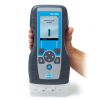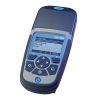Hach SL250 Single-Port Portable Parallel Analyzer
Hach's SL250 Portable Parallel Analyzer (PPA) is an innovative multiparameter water quality meter that allows you to simultaneously perform colorimetric and probe-based measurements.
Features
- Single instrument combines colorimetric and probe-based testing
- All chemicals and processes are entirely contained inside the Chemkey
- Automatic parameter selection and measurement processes for repeatable results
- Free ground shipping
- Expedited repair and warranty service
- Lifetime technical support
- More
Hach's SL250 Portable Parallel Analyzer (PPA) is an innovative multiparameter water quality meter that allows you to simultaneously perform colorimetric and probe-based measurements. The instrument and corresponding Chemkey reagents are easy to use regardless of technical expertise. Compared to traditional powder or liquid reagent methods, Chemkeys use a simplified testing method that requires no sample preparation, making the process significantly easier, faster, and safer while drastically reducing variability in results.
Colorimetric tests include free chlorine, total chlorine, fluoride, high range manganese, zinc, copper, nitrite, dissolved iron, high and low range alkalinity, high and low range orthophosphate, high and low range hardness, peracetic acid, and more.
Probe-based tests include pH, dissolved oxygen, conductivity, and more.
*Not suitable for chloramination applications*
| Battery Life | >200 Chemkey tests per full battery charge |
| Certifications | CE, UKCA, FCC, ISED, RCM, KC |
| Connector | 5-Pin Input Connector: Two M12 connectors for IntelliCal™ probes |
| Data Memory | Memory: 1000 measured values (result, date, time, site ID, user ID) |
| Data Storage | Automatic in Press to Read measurement mode. Manual in Continuous measurement mode |
| Detector | Silicon photodiode |
| Dimensions | 13.08 x 5.89 x 25.83 cm (5.15 x 2.32 x 10.17 in.) |
| Enclosure Rating | IP54 |
| Instrument Bundle | SL250 Single-Port Portable Parallel Analyzer (PPA) |
| Interfaces | Mini USB port |
| Lock Function | For IntelliCAL™ Probes: Press to Read and Continuous measurement mode |
| Measurement Modes | Transmittance (%), Absorbance (abs) and Concentration (Conc) |
| Number of Channels | 1 |
| Operating Temperature Range | 5 - 50 °C (41 - 122 °F), maximum 85% relative humidity (non-condensing) |
| Output Voltage | 12 V at 3A output |
| Power Requirements (Hz) | 50/60 Hz |
| Power Requirements (Voltage) | 100 - 240 VAC |
| Power Supply | 2.5 mm Jack |
| Protection Class | III |
| Temperature | Charging Temperature: 5 - 45 °C (41 - 113 °F), maximum 85% relative humidity (noncondensing) Storage Temperature: -20 - 60 °C (-4 - 140 °F), maximum 85% relative humidity (noncondensing) |
| Temperature Correction | For IntelliCAL Probes: Off, automatic and manual (parameter dependent) |
| Temperature Input | 5 - 45 °C (41 - 113 °F), maximum 85% relative humidity (non-condensing) |
| Warranty | 12 months |
| Weight | 1.0 kg (2.2 lb) |
| What's included? | SL250 PPA with carry case, 125 V power cable and manual |
- (1) SL250 portable parallel analyzer (PPA)
- (1) Carry case
- (1) 125 V power cable
- (1) Manual
In The News
Save our Bogs! Culture, Conservation and Climate Action in Ireland’s Peatlands
Characterized by long-term accumulation under waterlogged conditions, peatlands exist on every continent and account for 3-4% of the global land surface . Small but mighty, these often overlooked wetland environments are estimated to hold as much as one-third of the world's organic carbon in their soil—twice the amount found in the entirety of the Earth's forest biomass. While healthy peatlands can trap and store carbon, regulate water, and provide important habitats for rare species, human alteration has disturbed peatland carbon and nitrogen cycles on a global scale. Approximately 12% of the world’s peatlands have been drained and degraded through conversion for agriculture, forestry, infrastructure development, and other uses.
Read MoreSargassum Surge: How Seaweed is Transforming our Oceans and Coastal Ecosystems
Until recently, Sargassum –a free-floating seaweed–was distributed throughout the Sargasso Sea , the north Caribbean Sea, and the Gulf of Mexico. But in the space of a decade, this seaweed has, as one scientist remarks , “Gone from a nonfactor to the source of a terrible crisis.” Driven by climate change, anomalous North Atlantic Oscillation in 2009-2010 and a glut of anthropogenic pollutants, sargassum has proliferated. Seasonally recurrent mats as deep as 7m now bloom in the “Great Atlantic Sargassum Belt” (GASB), which covers areas of the Atlantic from West Africa to the Caribbean Sea and Gulf of Mexico. Every year, millions of tons wash up along the shores of more than 30 countries . Dr.
Read MoreGreat Lakes Research Center: Designing Targeted Monitoring Solutions
According to the National Oceanic and Atmospheric Administration ( NOAA ), the Great Lakes have more miles of coastline than the contiguous Atlantic and Pacific coasts combined and contain 20 percent of the world's freshwater, making it a critical region to protect and conserve. Continuous monitoring and data-informed resource management are key components of managing waters in the region. Hayden Henderson, a research engineer with the Great Lakes Research Center (GLRC), designs and deploys monitoring platforms throughout the Great Lakes. With a background in environmental engineering, Henderson enjoyed the challenge of creating systems and making them work to obtain difficult, remote measurements.
Read More









































